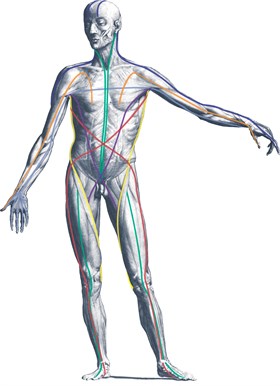
Anatomy Trains Structural Integration explained
ATSI is a form of Structural Integration working with unique myofascial lines developed by Tom Myers called Anatomy Trains. These lines map connections through the whole body from foot to head, front to back and superficial to deep. Imbalances add strain to the body’s structure and can be felt as aches which often manifest over time into acute pain.
Sessions look at the whole body and aim to balance the Anatomy Trains lines using hands on precise anatomical techniques. The techniques release the connective tissue (fascia) to re-form tissue health, resolve complex postural and movement patterns and align the whole body. The changes provoke ease of movement, greater balance and enhanced physical performance.
To achieve long standing results a structured series of 12 sessions is most affective. Angela’s skill is to specifically design the series to suit individual problem(s). What may be felt on the surface may not be the cause. The sessions will work all areas of the body from toe to head and superficial to deep; allowing the body to rebalance. Integrating the whole system is an approach that sets Structural Integration apart from other kinds of bodywork or manual therapies.
There are several schools teaching Structural Integration primarily based on the pioneering work of Dr. Ida Rolf. Tom Myers, the founder of Anatomy Trains trained with Dr. Rolf and has practiced integrative bodywork for over 30 years in Europe, the UK, and the USA. Throughout his career Tom and has been influenced by other forms of movement work: Mosche Feldenkrais, Judith Aston and Emilie Conrad with some of these techniques being incorporated into ATSI.

Anatomy Trains Structural Integration explained
ATSI is a form of Structural Integration working with unique myofascial lines developed by Tom Myers called Anatomy Trains. These lines map connections through the whole body from foot to head, front to back and superficial to deep. Imbalances add strain to the body’s structure and can be felt as aches which often manifest over time into acute pain.
Sessions look at the whole body and aim to balance the Anatomy Trains lines using hands on precise anatomical techniques. The techniques release the connective tissue (fascia) to re-form tissue health, resolve complex postural and movement patterns and align the whole body. The changes provoke ease of movement, greater balance and enhanced physical performance.
To achieve long standing results a structured series of 12 sessions is most affective. Angela’s skill is to specifically design the series to suit individual problem(s). What may be felt on the surface may not be the cause. The sessions will work all areas of the body from toe to head and superficial to deep; allowing the body to rebalance. Integrating the whole system is an approach that sets Structural Integration apart from other kinds of bodywork or manual therapies.
There are several schools teaching Structural Integration primarily based on the pioneering work of Dr. Ida Rolf. Tom Myers, the founder of Anatomy Trains trained with Dr. Rolf and has practiced integrative bodywork for over 30 years in Europe, the UK, and the USA. Throughout his career Tom and has been influenced by other forms of movement work: Mosche Feldenkrais, Judith Aston and Emilie Conrad with some of these techniques being incorporated into ATSI.
What is fascia?
Tom Myers explains in three minutes
Fascia Guide asked Tom Myers "What is Fascia?" His answer became this 3 min YouTube video.
Thank you to Fascia Guide YouTube Channel: https://www.youtube.com/watch?v=STVxwAoQvME
Fascia is a structure of connective tissue that surrounds muscles, groups of muscles, blood vessels, and nerves, binding some structures together, while permitting others to slide smoothly over each other. Various kinds of fascia may be distinguished. They are classified according to their distinct layers, their functions and their anatomical location: superficial fascia, deep (or muscle) fascia, and visceral (or parietal) fascia.
Anatomy Trains

Anatomy Trains myofascial meridians were developed by Tom Myers and published in his book in 2001. They are a unique map of the fascial connections through muscles that have for many in the industry, lead to a new understanding of connectivity in the body, especially for long-standing compensatory patterns in stance and movement. Instead of only looking at muscle origins and insertions we are now looking at fascial connectivity and how tightness can inhibit function and movement.
Opposite Tom Myers talks through Tensegrity Geometry, developed by Buckminster Fuller, an architect. This is an excellent way of showing how important it is for the human body to have an even toned balance across the myofascial system allowing for optimum physiology for both artery and nerve, the organs in their cavities and for efficient skeletal alignment.
The Anatomy Trains (To find out more please visit Tom's website www.anatomytrains.com and www.anatomytrains.co.uk)
- Superficial front line
- Superficial back line
- Lateral line
- Spiral line
- Deep front line
- Arm line
- Functional line
Tensegrity
Tom Myers, founder of Anatomy Trains describes tensegrity and the relationship to human structure.
Tensegrity is a model for understanding the geometry of the body, on both a micro and a macro-cosmic scale, that leads to many new insights in terms of body connectivity, the relation between stability and movement, and how we can develop what might be called “Spatial Medicine”
Find out more about tensegrity geometry.
Get in touch
Angela Radley (Donovan)
2 The Covert
York
YO24 1JN
Telephone: 07950 028 016





